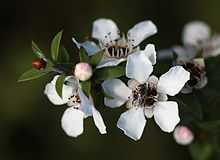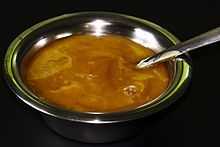Mānuka honey


Mānuka honey is a monofloral honey produced in New Zealand and Australia from the nectar of the mānuka tree. The honey is commonly sold as an alternative medicine. While a component found in Manuka honey has demonstrated antibacterial properties in vitro, there is no conclusive evidence of benefit in medical use and no evidence that the whole honey has any benefit.
Identification
Mānuka honey is produced by introduced European honey bees (Apis mellifera)[1] feeding on the mānuka or tea tree (Leptospermum scoparium and/or Leptospermum polygalifolium)[2] which grows uncultivated throughout New Zealand and southeastern Australia.
Mānuka honey is markedly thixotropic and has shown the highest viscosity among a range of studied honeys. This property is due to the presence of a protein or colloid and is its main visually defining character, along with its typical dark cream to dark brown colour.[3][4] To be labelled New Zealand mānuka honey,[5] at least 70% of its pollen content should come from Leptospermum scoparium.[4]
The mānuka tree flowers more or less at the same time as Kunzea ericoides, another Myrtaceae species also called Kānuka, which often shares the same growing areas as the former species. Some apiarists cannot readily differentiate these two species from each other. Both flowers have a similar morphology and pollen differentiation between the two species is very difficult. Therefore, melissopalynology as identification for the type of honey is valid only in association with other identification tests. In particular, L. scoparium honey is dark, whereas K. ericoides honey is pale yellow and clear, with a "delicate, sweet, slightly aromatic" aroma and a "sweet, slightly aromatic" flavour, and is not thixotropic.[4]
Heather (Calluna vulgaris) honey is also thixotropic, but the plant flowers in late summer and its montane distribution area does not correspond with that of Leptospermum scoparium. Therefore, its harvest cannot be mistaken for that of manuka honey.[4]
Food
Manuka honey has a strong flavour,[3] which has been characterised as, "earthy, oily, herbaceous",[6] and "florid, rich and complex".[7] It is described by the New Zealand honey industry as having a "damp earth, heather, aromatic" aroma and a "mineral, slightly bitter" flavour.[4]
Medicinal properties
A 2008 Cochrane Review found that honey may help improve superficial burns compared to some types of standard dressing, but there was insufficient evidence from studies, very few of which were on mānuka honey, to be conclusive, and the use of honey for leg ulcers provided no benefit. The review found that there was insufficient evidence for any benefit in other types of chronic wounds, as all of the data came from a single centre of research, and that "data from trials of higher quality found honey had no significant effect on healing rates or had significantly slower rates of healing".[8] Methylglyoxal is the major antibacterial component of mānuka honey.[9] In vitro studies indicate methylglyoxal is an effective antimicrobial agent against forms of MRSA,[10][11] although studies have not been done in humans.[8][12]
Mānuka honey, alongside other antibacterial products, does not reduce the risk of infection following treatment for ingrown toenails.[13]
Counterfeiting and other price-related problems
In the wake of the high premium paid for mānuka honey, the majority of product now labelled as such worldwide is counterfeit or adulterated. According to research by UMFHA, the main trade association of New Zealand mānuka honey producers, whereas 1,700 tons of mānuka honey are made there annually representing almost all the world's production, some 10,000 tons of produce is being sold internationally as mānuka honey, including 1,800 tons in the UK.[14]
In governmental agency tests in the UK between 2011 and 2013, a majority of mānuka-labelled honeys sampled lacked the non-peroxide anti-microbial activity exclusive to mānuka honey. Likewise, of 73 samples tested by UMFHA in Britain, China and Singapore in 2012-13, 43 tested negative on the same count. Separate UMFHA tests in Hong Kong found that 14 out of 55 mānuka honeys sampled had been adulterated with syrup. In 2013 the UK Food Standards Agency asked all trading standards authorities to alert all mānuka honey vendors to the need for legal compliance.[14]
There is a confusing range of systems for rating the strength of mānuka honeys. In one UK chain in 2013, two products were labelled “12+ active” and “30+ total activity” respectively for “naturally occurring peroxide activity” and another “active 12+” in strength for “total phenol activity”, yet none of the three was labelled for the strength of the non-peroxide antimicrobial activity specific to mānuka honey.[14]
One reason for bona fide mānuka honeys to vary in the last regard is that the bees cannot be forced to forage only on mānuka flowers, especially given the pressures toward maximal exploitation of known blooms. So intense is the demand for the correct trees that New Zealand honey farmers have been using helicopters to locate them and deploy hives nearby.[14] There have been increasing turf disputes between producers operating close to large mānuka tree clumps, and also cases reported of many hives being variously sabotaged or stolen.[15]
At least one British supermarket has taken to stocking jars of the honey in tagged security cassettes, such were the losses from shoplifting.[16]
Medihoney
Medihoney is a registered trademark of Derma Sciences, Inc.. According to the company's web site, Medihoney is a medical-grade honey product used for the management of wounds and burns, derived from the Leptospermum scoparium species of plant in New Zealand. Derma Sciences has two manufacturing facilities, one in Toronto, Canada, and one in China, along with other contracts for manufacturing services for OEM and private label products.[17][18][19]
See also
References
- ↑ Matheson, Andrew; Reid, Murray (2011). Practical beekeeping in New Zealand (Fourth edition. ed.). ISBN 9781877568527.
- ↑ Tanguy, C. Marina Marchese & Kim Flottum ; illustrations by Elara (2013). The honey connoisseur : selecting, tasting, and pairing honey, with a guide to more than 30 varietals. ISBN 9781579129293.
- ↑ 3.0 3.1 Jon Morgan (5 March 2009). "Money from honey - a family affair". Dominion Post. Retrieved 12 March 2011.
- ↑ 4.0 4.1 4.2 4.3 4.4 The factors responsible for the varying levels of UMF® in mānuka (Leptospermum scoparium) honey. Jonathan McD C Stephens. Doctorate thesis. 2006.
- ↑ Ministry for Primary Industries. "Interim Labelling Guide for Manuka Honey". New Zealand Government. Retrieved 22 December 2014.
- ↑ Julie Biuso, Sizzle: Sensational Barbecue Food, Monterey, Cal.: Julie Biuso Publications, 2008, p. 154
- ↑ Crescent Dragonwagon, Passionate Vegetarian, New York: Workman Publishing Co., 2002, p. 958
- ↑ 8.0 8.1 Jull, AB; Rodgers, A; Walker, N (Oct 8, 2008). "Honey as a topical treatment for wounds.". Cochrane database of systematic reviews (Online) (4): CD005083. doi:10.1002/14651858.CD005083.pub2. PMID 18843679.
- ↑ Majtan, J; Klaudiny, J; Bohova, J; Kohutova, L; Dzurova, M; Sediva, M; Bartosova, M; Majtan, V (Feb 17, 2012). "Methylglyoxal-induced modifications of significant honeybee proteinous components in manuka honey: Possible therapeutic implications.". Fitoterapia 83 (4): 671–7. doi:10.1016/j.fitote.2012.02.002. PMID 22366273.
- ↑ Kilty, S. J.; Duval, M.; Chan, F. T.; Ferris, W.; Slinger, R. (2011). "Methylglyoxal: (active agent of manuka honey) in vitro activity against bacterial biofilms". International Forum of Allergy & Rhinology 1 (5): 348–350. doi:10.1002/alr.20073. PMID 22287464.
- ↑ Mavric, E.; Wittmann, S.; Barth, G.; Henle, T. (2008). "Identification and quantification of methylglyoxal as the dominant antibacterial constituent of Manuka (Leptospermum scoparium)honeys from New Zealand". Molecular Nutrition & Food Research 52 (4): 483–489. doi:10.1002/mnfr.200700282. PMID 18210383.
- ↑ Lusby, PE; Coombes, A; Wilkinson, JM (November 2002). "Honey: a potent agent for wound healing?". Journal of wound, ostomy, and continence nursing: official publication of The Wound, Ostomy and Continence Nurses Society / WOCN 29 (6): 295–300. doi:10.1067/mjw.2002.129073. PMID 12439453.
- ↑ Eekhof, JA; Van Wijk, B; Knuistingh Neven, A; van der Wouden, JC (Apr 18, 2012). "Interventions for ingrowing toenails.". Cochrane database of systematic reviews (Online) 4: CD001541. doi:10.1002/14651858.CD001541.pub3. PMID 22513901.
- ↑ 14.0 14.1 14.2 14.3 Jonathan Leake (26 August 2013). "Food fraud buzz over fake manuka honey". The Times (London). Retrieved 28 December 2013.
- ↑ Mike Barrington (7 November 2012). "Honey fights: Millions of bees slaughtered". The New Zealand Herald. Retrieved 28 December 2013.
- ↑ Sean Poulter (10 August 2013). "The £20 jar of honey that needs a security tag to deter middle-class shoplifters". Daily Mail. Retrieved 30 December 2013.
- ↑ "About Derma Sciences, Inc.". DermaSciences.com. Retrieved September 10, 2014.
- ↑ "About MEDIHONEY". DermaSciences.com. Retrieved September 10, 2014.
- ↑ Journal of Pharmacognosy and Phytotherapy Vol. 4(1), pp. 6-11, January 2012: A convenient new analysis of dihydroxyacetone and methylglyoxal applied to Australian Leptospermum honeys
External links
- What's special about Active Manuka Honey? from University of Waikato Honey Research Unit
- "Honey can reverse antibiotic resistance, study suggests". Science Daily. 13 April 2011.
- Published clinical data Information with references supplied by Advancis Medical Ltd